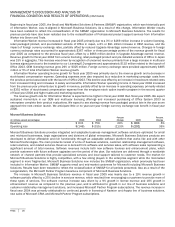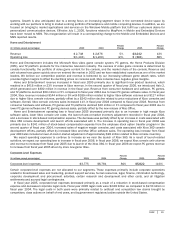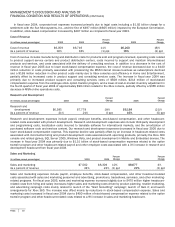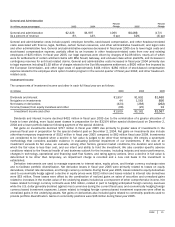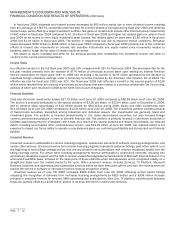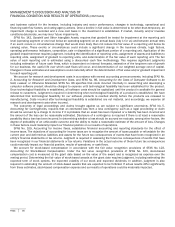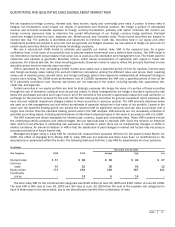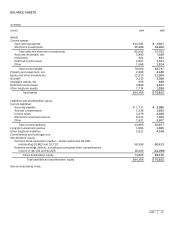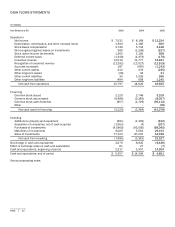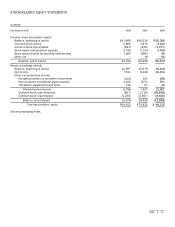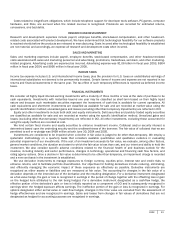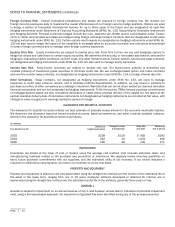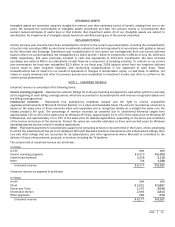Microsoft 2005 Annual Report Download - page 36
Download and view the complete annual report
Please find page 36 of the 2005 Microsoft annual report below. You can navigate through the pages in the report by either clicking on the pages listed below, or by using the keyword search tool below to find specific information within the annual report.
PAGE 35
commitments includes an analysis of all known contracts exceeding $5 million in the aggregate and all known open
purchase orders. We expect to fund these commitments with existing cash and cash flows from operations.
(5) We have excluded unearned revenue of $1.67 billion from other long-term liabilities presented above as these will not be
settled in cash.
RECENTLY ISSUED ACCOUNTING STANDARDS
In November 2004, the Financial Accounting Standards Board (FASB) issued SFAS No. 151, Inventory Costs, which clarifies the
accounting for abnormal amounts of idle facility expense, freight, handling costs, and wasted material. SFAS No. 151 will be
effective for inventory costs incurred during fiscal years beginning after June 15, 2005. We do not believe the adoption of SFAS
No. 151 will have a material impact on our financial statements.
In December 2004, the FASB issued SFAS No. 153, Exchanges of Nonmonetary Assets, which eliminates the exception for
nonmonetary exchanges of similar productive assets and replaces it with a general exception for exchanges of nonmonetary
assets that do not have commercial substance. SFAS No. 153 will be effective for nonmonetary asset exchanges occurring in
fiscal periods beginning after June 15, 2005. We do not believe the adoption of SFAS No. 153 will have a material impact on
our financial statements.
In December 2004, the FASB issued SFAS No. 123(R), Share-Based Payment, which establishes standards for transactions
in which an entity exchanges its equity instruments for goods or services. This standard requires an issuer to measure the cost
of employee services received in exchange for an award of equity instruments based on the grant-date fair value of the award.
This eliminates the exception to account for such awards using the intrinsic method previously allowable under Accounting
Principles Board (APB) Opinion No. 25. In March 2005, the SEC released Staff Accounting Bulletin (SAB) 107, Share-Based
Payment, which expresses views of the SEC Staff about the application of SFAS No. 123(R). In April 2005 the SEC issued a rule
that SFAS No. 123(R) will be effective for annual reporting periods beginning on or after June 15, 2005. We previously adopted
the fair value recognition provisions of SFAS No. 123, Accounting for Stock-Based Compensation, on July 1, 2003 and restated
previous periods at that time for all awards granted to employees after July 1, 1995. Accordingly we believe SFAS No. 123(R)
will not have a material impact on our financial statements; however, we continue to assess the potential impact that the
adoption of SFAS No. 123(R) will have on the classification of tax deductions for stock-based compensation in our statements of
cash flows.
APPLICATION OF CRITICAL ACCOUNTING POLICIES
Our financial statements and accompanying notes are prepared in accordance with U.S. GAAP. Preparing financial statements
requires management to make estimates and assumptions that affect the reported amounts of assets, liabilities, revenue, and
expenses. These estimates and assumptions are affected by management’s application of accounting policies. Critical
accounting policies for us include revenue recognition, impairment of investment securities, impairment of goodwill, accounting
for research and development costs, accounting for legal contingencies, accounting for income taxes, and accounting for stock-
based compensation.
We account for the licensing of software in accordance with American Institute of Certified Public Accountants (AICPA)
Statement of Position (SOP) 97-2, Software Revenue Recognition. The application of SOP 97-2 requires judgment, including
whether a software arrangement includes multiple elements, and if so, whether vendor-specific objective evidence (VSOE) of fair
value exists for those elements. Customers receive certain elements of our products over a period of time. These elements
include free post-delivery telephone support and the right to receive unspecified upgrades/enhancements of Microsoft Internet
Explorer on a when-and-if-available basis, the fair value of which is recognized over the product’s estimated life cycle. Changes
to the elements in a software arrangement, the ability to identify VSOE for those elements, the fair value of the respective
elements, and changes to a product’s estimated life cycle could materially impact the amount of earned and unearned revenue.
Judgment is also required to assess whether future releases of certain software represent new products or upgrades and
enhancements to existing products.
SFAS No. 115, Accounting for Certain Investments in Debt and Equity Securities, and SEC SAB 59, Accounting for Noncurrent
Marketable Equity Securities, provide guidance on determining when an investment is other-than-temporarily impaired.
Investments are reviewed quarterly for indicators of other-than-temporary impairment. This determination requires significant
judgment. In making this judgment, we employ a systematic methodology quarterly that considers available quantitative and
qualitative evidence in evaluating potential impairment of our investments. If the cost of an investment exceeds its fair value,
we evaluate, among other factors, general market conditions, the duration and extent to which the fair value is less than cost,
and our intent and ability to hold the investment. We also consider specific adverse conditions related to the financial health of



